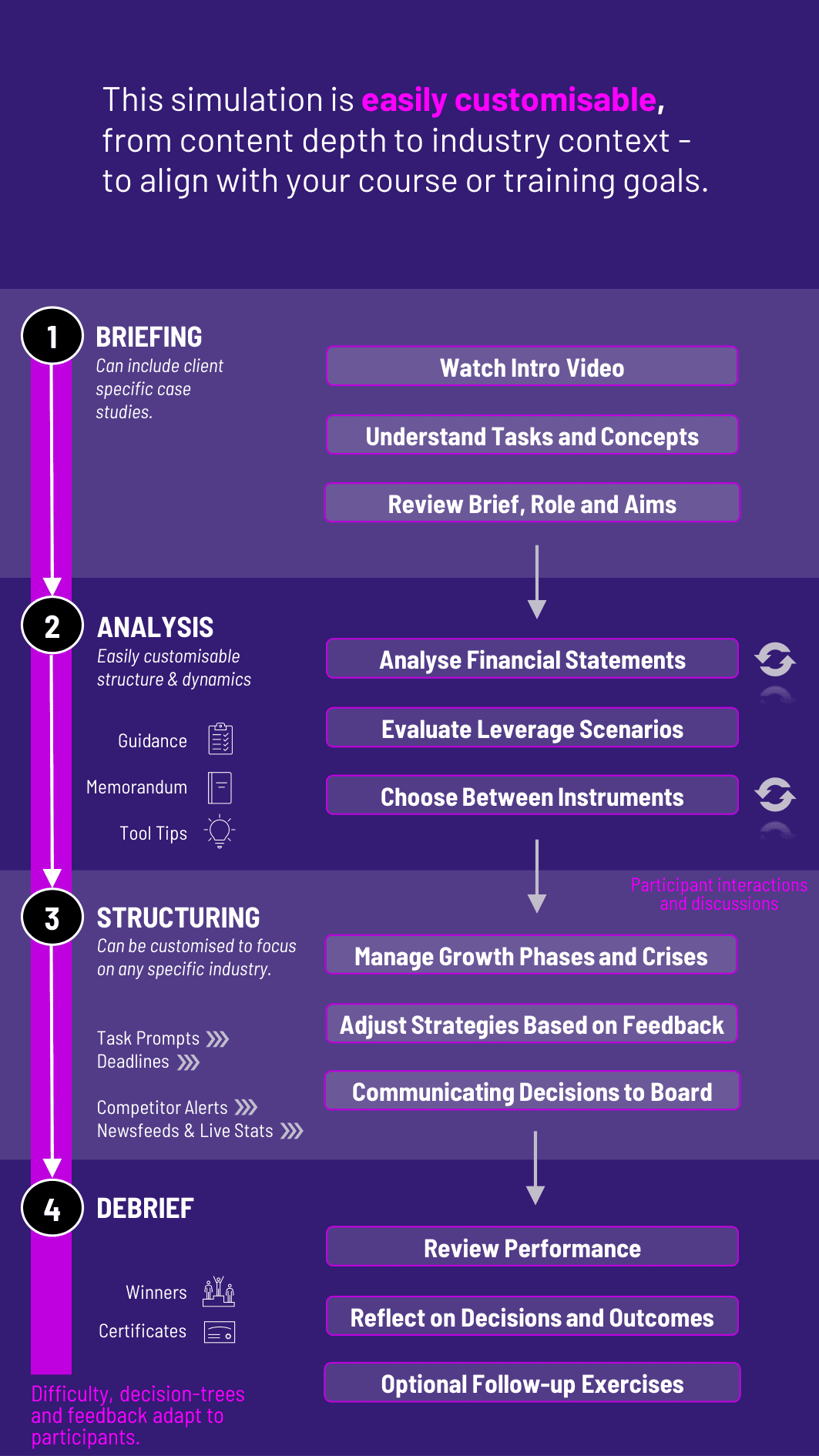
In this course, participants act as CFOs tasked with optimizing the capital structure. They balance debt and equity under changing market, credit, and strategic conditions to maximize firm value.
Debt vs. Equity Trade-offs
Optimal Capital Structure Theory (Modigliani-Miller, trade-off theory, pecking order)
Cost of Capital (WACC adjustments based on capital mix)
Credit Ratings and Interest Rates
Market Signaling and Investor Perception
Covenants and Financial Flexibility
Impact of Capital Structure on Valuation
Scenario-Based Stress Testing


Analyzing financial statements and capital costs
Evaluating leverage scenarios under varying business forecasts
Choosing between issuing debt, equity, or hybrid instruments
Assessing the impact of capital changes on WACC, credit rating, and shareholder value
Communicating funding decisions to boards, analysts, and investors
Managing capital structure during growth phases, crises, or M&A events
Adjusting strategy based on simulated stakeholder feedback and market dynamics
By the end of the course, participants will:
Understand the core principles of capital structure theory
Apply capital mix decisions to real-world financial challenges
Evaluate how financing choices affect risk, cost of capital, and valuation
Respond to shifts in macroeconomic conditions, credit markets, and investor sentiment
Build persuasive narratives to justify financing strategies
Work cross-functionally to balance capital access with operational needs
Apply stress-testing and scenario planning to financial strategy
The course’s flexible structure ensures that these objectives can be calibrated to match the depth, duration, and focus areas of each program.
1. Scenario Introduction Participants receive a business case with financials, goals, and constraints.
2. Capital Assessment They evaluate existing capital structure, debt maturities, and liquidity.
3. Decision Making Participants make funding choices (e.g., refinance debt, issue new equity, or adjust mix).
4. Market and Stakeholder Feedback Their decisions affect stock price, credit score, investor sentiment, and financial ratios.
5. Board-Level Communication Participants justify their capital strategy through memos or presentations.
6. Next-Round Adaptation Each new cycle introduces a new economic context, requiring recalibration.
Is this suitable for students and professionals? Yes. It’s adaptable for MBA, undergrad, or corporate course contexts.
Does the course include credit ratings? Yes. Creditworthiness and market conditions influence interest rates and financing access.
Do participants use WACC? Yes. They calculate and optimize WACC to guide financing decisions.
Is it based on real industry cases? Scenarios are fictional but modeled after real market conditions and sectors.
How long is the course? It can be delivered in a 2 - 3 hour duration or stretched over multiple sessions.
Can it be used in valuation or corporate strategy courses? Absolutely. Capital structure decisions are central to valuation and long-term planning.
Does it simulate financial crises or economic downturns? Yes. Participants face shocks like recession, rating downgrades, or liquidity crunches.
Can it be run in teams? Yes. Teams can take on roles like CFO, treasurer, or investor relations lead.
Are stakeholder communications included? Yes. Participants justify decisions via board memos, presentations, or press releases.
How is performance assessed? Based on WACC optimization, valuation impact, financial stability, and quality of rationale.
Financial soundness and realism of capital decisions
Strategic consistency over multiple course rounds
Responsiveness to market signals and economic shifts
Clarity and persuasiveness in written or verbal communication
Collaboration, if run in team format
Understanding of how capital mix impacts valuation and risk
Deliverables can include investment memos, capital structure reports, or final board presentations. Additionally, you can also add a built-in peer and self-assessment tool to see how participants rate themselves. This flexibility allows the simulation to be easily integrated by professors as graded courses at universities.
Join this 20-minute webinar, followed by a Q&A session, to immerse yourself in the course.
or
Book a 15-minute Zoom demo with one of our experts to explore how the course can benefit you.